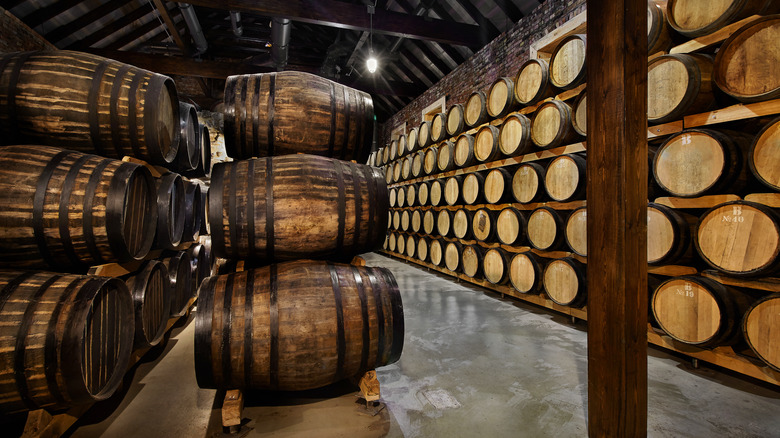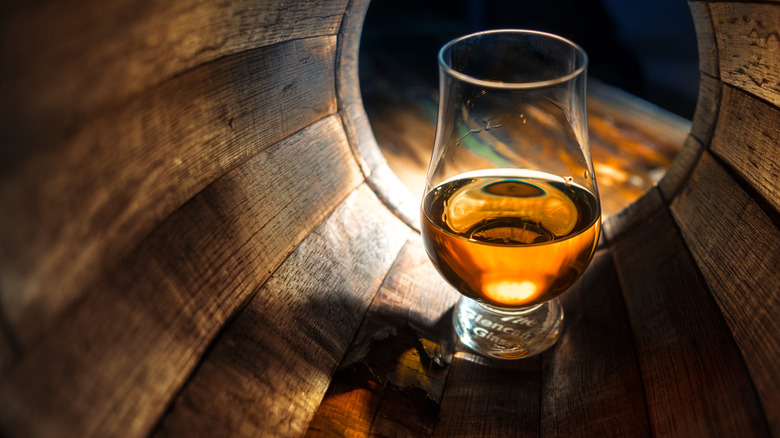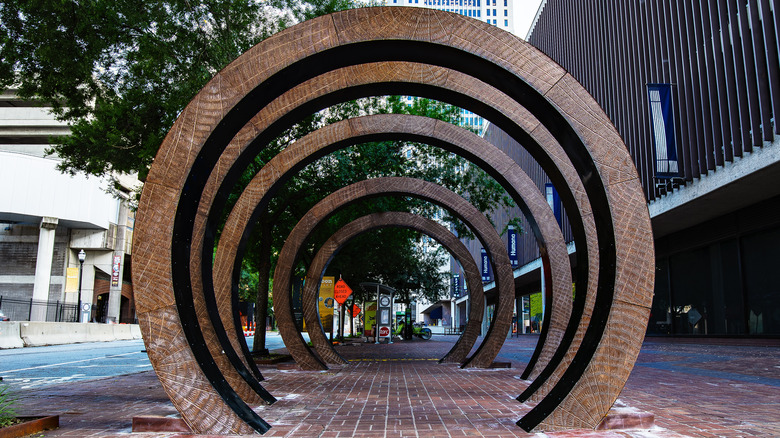Is There A Requirement For How Long Bourbon Can Be Aged?
A long-standing mystique surrounds the process of making whiskey, whether it's tall tales of Mississippi moonshiners or the smoky single-malt scotches from the Scottish Highlands. But bourbon has its own stories, all of which are American through and through. It's one of the few whiskeys that hold fast to the requirement that it be distilled in the U.S., at least if it bears the bourbon moniker, explains VinePair. It's backed by a congressional resolution from 1968, introduced by legislator John C. Watts from Kentucky, where most bourbon is still produced.
The resolution designates it as "a distinctive product of the United States that is unlike other types of alcoholic beverages, whether foreign or domestic." And that's not all, if it's legally labeled as a "straight bourbon" it must be aged in new, charred oak barrels, contain at least 51% corn mash, enter those barrels at a maximum of 125 proof, and enter subsequent bottles at a minimum of 80 proof, according to CNBC. No color or flavorings are allowed, only water when needed to dilute the strength.
With such purist criteria, surely there's a timeline for how long bourbon must age in the barrels, but it's not as high a standard as you'd imagine. Unless the bourbon is also bonded.
Age is more than a number
There is indeed a time requirement for aging bourbon, but again, only if bears the official, legal designation of straight bourbon. In that case, it must age in the barrels for at least two years, notes Liquor Laboratory. A further age distinction, available to bourbon and other alcohol distillers, is bottled-in-bond spirits, introduced in the Bottled in Bond Act of 1897.
The bonded label mandates that the bourbon matures for four years in a federally bonded warehouse, explains American Whiskey. Additional requirements for bonding state that the bourbon must come from a single distillery, the same distiller, and within a single distilling season. It's entirely voluntary but is often considered a symbol of honor and transparency within the industry.
That takes care of the minimum number of years, but what about the maximum? There is no legal limit on how long bourbon can age in the barrels before bottling, but that doesn't mean a distiller should let it sit past about 15 years. At that point, the bourbon could turn sour, bitter, and lose flavor complexity, according to Liquor Laboratory. Barrel Craft Spirits reveals that, for many respected bourbon distillers, the "sweet spot" where all the elements in a bourbon reach the perfect balance, happens between six and 12 years of maturation.
More than just a container
When determining a minimum and maximum age for bourbon distillation, it's not just about the ingredients in the barrel — the barrel itself becomes an ingredient, one that affects the final product in significant ways, explains Barrel Craft Spirits. Once unaged bourbon enters the barrel, it begins to pull elements from the oak wood and impart flavor, color, and aroma to the burgeoning new bourbon. It deepens over time, aided by small amounts of oxygen that seep in and instigate chemical reactions, creating a unique flavor profile.
Once removed from the barrel and bottled, no further aging occurs. It remains good for many years when unopened and stored properly, according to BinWise. After opening, it can lose color and flavor within a couple of years when the bottle is half full, or sooner with less liquid, due to oxidation.
After solidifying and standardizing bourbon production via the congressional resolution of 1968, Kentucky wasn't quite finished, per GovTrack. In 2007, Senate Resolution 294, introduced by Kentucky Senator Jim Bunning, declared September to be National Bourbon Heritage Month and recognized bourbon as "American's Native Spirit."


